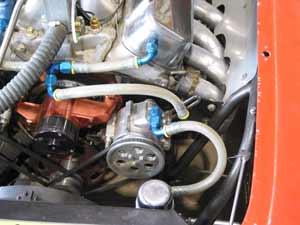| 
Another reason for having a pump produce more vacuum than
needed is that you can tailor the vacuum to come on earlier,
at your maximum torque rpm. Just as an indicator of how far
the crankcase evacuation development has gone, the original
header-evacuation designs of 30 years ago could only draw
three inches of vacuum.
 |
| The 555-inch badboy in Zucco’s
own Super-Gas ’57 Corvette illustrates the proper
plumbing of a Super-Pro system. Hoses from the front of
both valve covers lead to the intake port of the pump
(in Sportsman and pro applications plumbing to one valve
cover is usually sufficient), while the exhaust hose goes
directly to the breather tank. |
If there’s any drawback to a good vacuum evacuation
system it’s the shock of adding two tenths to your time
if anything goes wrong with the pump or its belt! The GZMS
line of pumps is warranted for one year and requires no maintenance
as long as sufficient oil mist passes through them. Pumps
have operated for several years on racecars such as Zucco’s
own Super-Gas ’57 Corvette and Doug Bracy's Super-Gas
'40 Willys pickup, and can last even longer on engines running
synthetic oil, which seems to “agree with” Teflon
and carbon-fiber materials.
“As long as there is some oil vapor in the line from
your valve cover to the pump,” says Zucco, “the
Teflon will live just fine.” In most installations,
a hose fitting is installed in the end of the valve cover,
which usually guarantees adequate oil mist. "The engine
should be well sealed and have no air entry to the crankcase,”
says Zucco. “There should be no air entry at the dipstick
or leaky gaskets, and under no circumstances should you have
an old-fashioned breather on the engine at all.”
Moisture in the evacuation system is common, but isn’t
a problem unless it’s allowed to sit in the pump for
an extended period. GZ Motorsports recommends that the car
always be warmed up enough to get the vacuum pump warm, which
will dissipate the moisture. Also, when setting up your system,
route your plumbing so that there are no low points in the
hoses that could collect moisture.
A proper evac setup will include a breather tank, preferably
mounted nearby and below the pump. Aluminum tanks are available
from GZMS with a pump kit, and include both a breather at
the top of the tank and a drain at the bottom. The GZMS tanks
are baffled inside to help prevent oil mist coming out of
the breather. Ideally, you’ll only get about a teaspoon
of oil per run when you drain the tank. The 1-pint GZMS tank
is small and light at only one pound. When you first run your
car with a vacuum system, the tank should be drained every
run to check the contents, but after that only as needed.
No oil when you drain could indicate a too-dry environment
for the pump, and too much oil could cause an oil overflow
problem if not drained. The excess is usually caused by too
much oil in the air nearest the inlet for the tank, and the
remedy is moving or baffling the tank.
There are variables in any engine combination, but a recent
example of a typical Sportsman application with a GZMS evacuation
system was a 347-cubic-inch small-block Ford built by Joe
Sherman Racing Engines. The power gains went from 8.4hp at
5400 rpm where the dyno test started to 23.4 hp at 8000. Without
the pump, the engine peaked at 8000 and then dropped, yet
with the pump the engine was still relatively flat in power
after its new peak at 8400-rpm. The engine’s peak power
level was 751.7hp, an amazing 31.3 hp more than the best without
the GZMS evac system!
The sport of drag racing certainly rivals necessity for being
the “mother of invention”, with almost every component
of today’s competition machines representing the most
recent derivative of some bright idea developed by one guy
- one racer who thought hard about a problem, and came up
with something to either last longer or go faster. The idea
of building a better system for evacuating crankcase pressure
isn’t going to make Zucco the subject for any bronze
statues in the park, but there are many Sportsman and Pro
racers out there who definitely appreciate this kind of horsepower-per-dollar
bargain. The other benefits, like keeping the engine clean
and making life easier for the rings are just icing on the
cinnamon roll!
|

